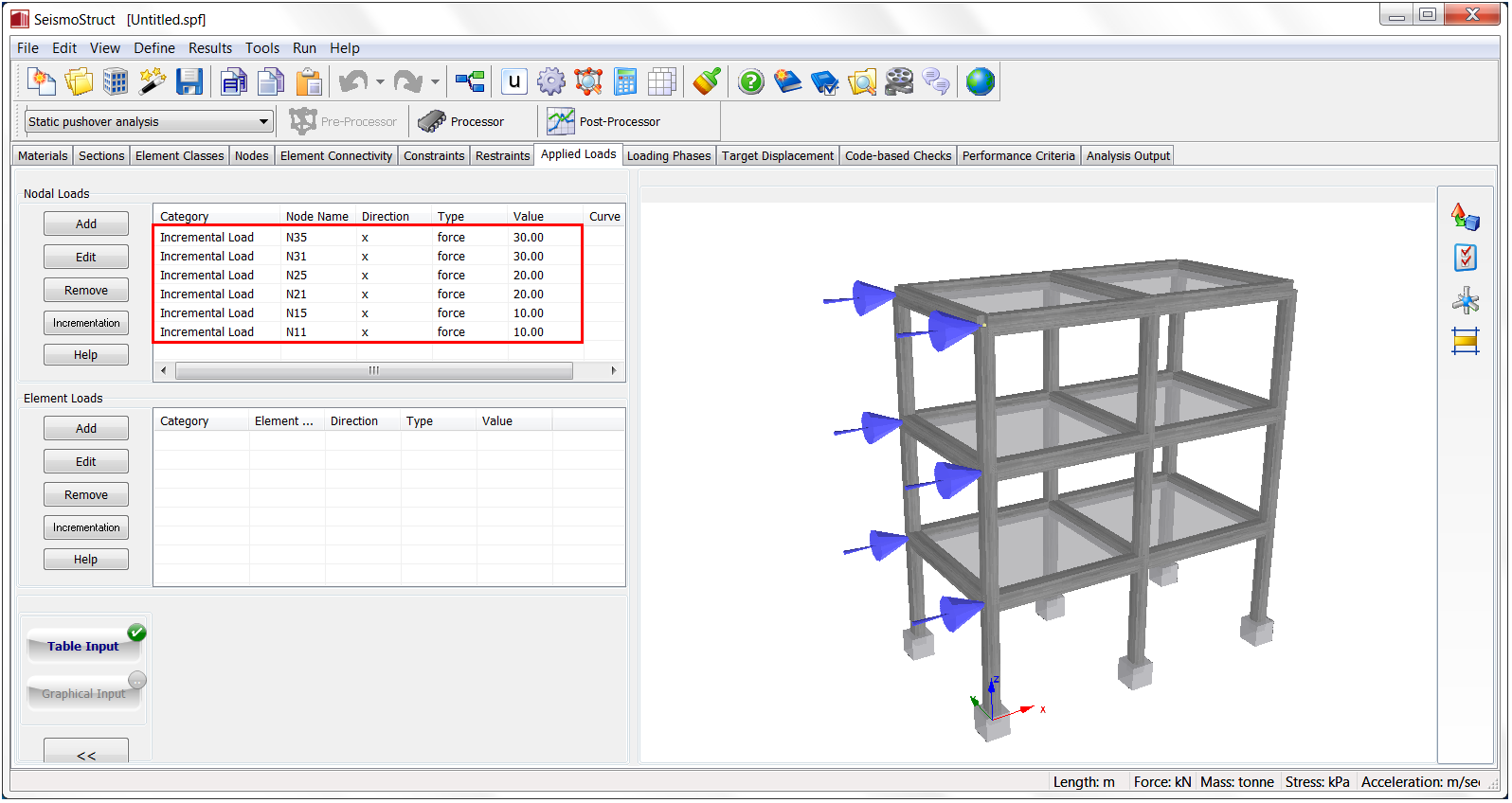Nodal loads
There are four nodal load categories in SeismoStruct, described below. These can be applied to any structural model, either in isolated fashion or in a combined manner, depending on the type of analysis being carried out. Further, it is noteworthy that the term "load", as employed in SeismoStruct, refers to any sort of action that can be applied to a structure, and may thus consist of forces, displacements and/or accelerations.

Permanent loads (dark blue arrows in rendering plot)
These comprise all static loads that are permanently applied to the structure. They can be forces (e.g. self-weight) or prescribed displacements (e.g. foundation settlement) applied at nodes. When running an analysis, permanent loads are considered prior to any other type of load, and can be used on all analysis types. Note that gravity loads should be applied downwards, for which reason they always feature a negative value.
Note: If it has been selected from the Project Settings -> Gravity & Mass menu that loads are derived from masses (in the gravity direction based on the g value, or in any translational direction, according to user-defined coefficients) and the model already features the presence of masses (defined in the materials, sections or element classes modules), then the program will automatically compute and apply distributed permanent loads.
Incremental loads (light blue arrows in rendering plot)
These represent pseudo-static loads (forces or displacements) that are incrementally varied. The magnitude of a load at any step is given by the product of its nominal value, defined by the user, and the current load factor, which is updated in automatic or user-defined fashion. Incremental loads are exclusively employed in pushover type of analyses, generally used to estimate horizontal structural capacity. Both adaptive and non-adaptive load profiles may be used, though the application of Displacements within an adaptive pushover framework stands out as the clearly recommended option [e.g. Antoniou and Pinho, 2004b; Pietra et al., 2006; Pinho et al., 2007].
Static time-history loads (light blue arrows in rendering plot)
These are static loads (forces and/or displacements) that vary in the pseudo-time domain according to user-defined loading curves. The magnitude of a load at any given time-step is computed as the product between its nominal value, defined by the user, and the variable load factor, characterised by the loading curve. This type of loads is used in static time history analysis and tsunami nonlinear analysis, commonly employed in the modelling of quasi-static testing of structures under various force or displacement patterns (e.g. cyclic loading).
Dynamic time-history loads (green arrows in rendering plots)
These are dynamic loads (accelerations or forces) that vary according to different load curves in the real time domain. The product of their constant nominal value and the variable load factor obtained from its load curve (e.g. accelerogram) at any particular time gives the magnitude of the load applied to the structure. These loads can be used in dynamic time history analysis, to reproduce the response of a structure subjected to an earthquake, or in incremental dynamic analysis, to evaluate the horizontal structural capacity of a structure.
All loads are defined in the Applied Loads module, where their category, node of application, type, direction and nominal value can be characterised. As in all other modules, the user is capable of adding new loads and removing/editing existing ones. In addition, a load incrementation facility is also available, so as to enable easier generation of new nodal actions. It functions in very much the same manner as the automatic generation of nodes does; the user defines node name and load value increments, and these are then employed to automatically generate new nodal actions through "repetition" of a selected set of already prescribed loads. This facility requires that node names respect the number (e.g. 100) or word+number (e.g. nod20) formats.
Notes
- The application of displacement loads to nodes constrained to displace together (e.g. through a rigid link or similar) may lead to convergence problems (because the applied displacements may be in contrast with the enforced constraint).
- With force-based frame element formulations it is possible to explicitly model loads acting along the member, and hence avoid the need for distributed loads to be transformed into equivalent point forces/moments at the end nodes of the element (and then for lengthy stress-recovery to be employed to retrieve accurate member action-effects). However, such feature could not yet be implemented in SeismoStruct.
- Note that strength and stiffness of infill elements are introduced after the application of the initial loads, so that the former do not resist to gravity loads (which are normally absorbed by the surrounding frame, erected first). If users wish their infills to resist gravity loads, then they should define the latter as non-initial loads.
- When assessing the horizontal capacity of non-symmetric structures, users should take care to consider the application of the incremental loads in both directions (i.e. run two pushover analyses) in order to identify the capacity of the structure in both its "weak" and "strong" directions.
- Users who wish to apply loads (including accelerograms) with an angle of incidence different from 90 degrees (e.g. 45°), can do so by defining such loads in terms of multiple-direction components (x, y, z).
- Explosions may produce three distinct types of loading: (i) air shock wave, which can be considered as an impulsive load, dynamic action or a quasi-static wave depending on its characteristics, (ii) dynamic pressure applied to the structure due to gas expansion and (iii) ground shock wave, which has three types of waves with different velocities and frequencies, namely, compression waves, shear waves and surface waves [Chege and Matalanga, 2000]. Therefore, Permanent, Static time-history > and Dynamic time-history loads should be employed when modelling this type of action.